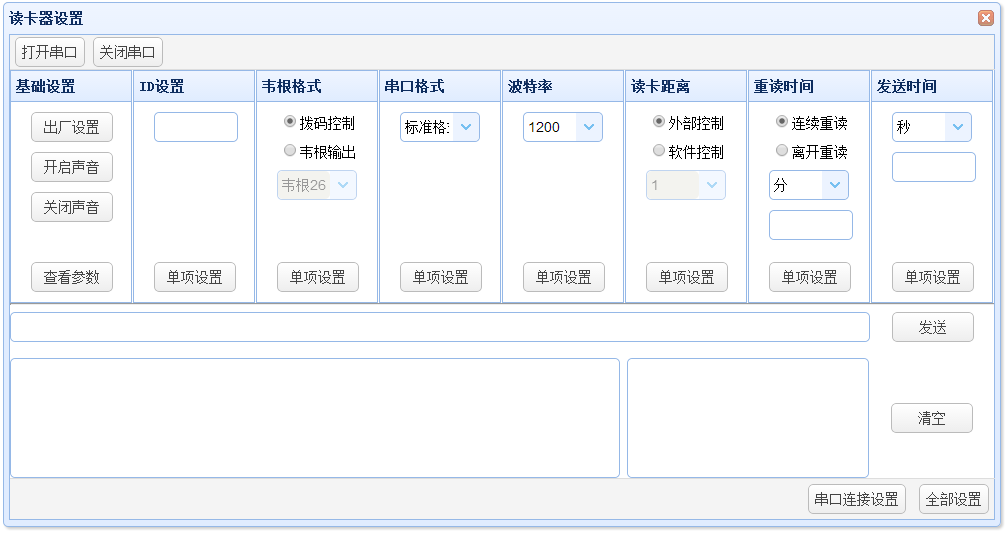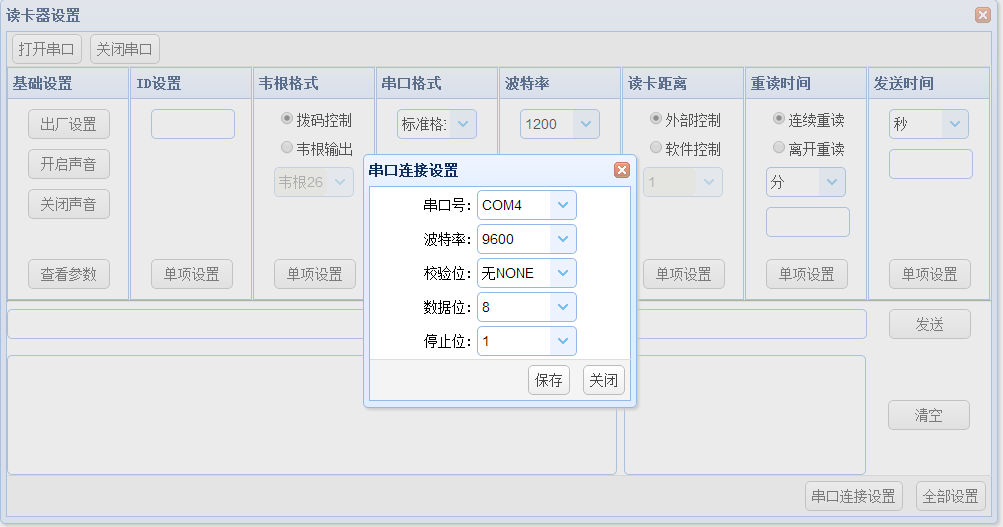本博文参考自https://www.cnblogs.com/Dreamer-1/p/5523046.html
没想到挺多人需要这个的,很高兴这篇文章能对大家有帮助,主要的工具类博文里已经有了,当然,要小工具源码的留言邮箱即可。 2019.09.05
最近接触到了串口及其读写,在此记录java进行串口读写的过程。
1.导入支持java串口通信的jar包:
在maven项目的pom.xml中添加RXTXcomm的依赖 或者 下载RXTXcomm.jar并导入到项目中。
支持Java串口通信操作的jar包,java.comm比较老,而且不支持64位系统,推荐使用Rxtx这个jar包(32位/64位均支持)。
下载地址:
http://files.cnblogs.com/files/Dreamer-1/mfz-rxtx-2.2-20081207-win-x86.zip (32位)
http://files.cnblogs.com/files/Dreamer-1/mfz-rxtx-2.2-20081207-win-x64.zip (64位)
注意:运行过程中抛出 java.lang.UnsatisfiedLinkError 错误或 gnu.io 下的类找不到时,将rxtx解压包中的 rxtxParallel.dll,rxtxSerial.dll 这两个文件复制到 C:\Windows\System32 目录下可解决该错误。
2.编写代码操作串口:
串口必要参数类:包含连接串口所必须的参数,方便在调用串口时设置和传递串口参数
/**
* 串口必要参数接收类
* @author: LinWenLi
* @date: 2018年7月21日 下午4:30:40
*/
public class ParamConfig {
private String serialNumber;// 串口号
private int baudRate; // 波特率
private int checkoutBit; // 校验位
private int dataBit; // 数据位
private int stopBit; // 停止位
public ParamConfig() {}
/**
* 构造方法
* @param serialNumber 串口号
* @param baudRate 波特率
* @param checkoutBit 校验位
* @param dataBit 数据位
* @param stopBit 停止位
*/
public ParamConfig(String serialNumber, int baudRate, int checkoutBit, int dataBit, int stopBit) {
this.serialNumber = serialNumber;
this.baudRate = baudRate; this.checkoutBit = checkoutBit; this.dataBit = dataBit; this.stopBit = stopBit; }
getter()... setter()... }
串口操作类:(其中包含的CustomException是自定义异常类,仅用于抛出异常原因。)
import gnu.io.CommPortIdentifier;
import gnu.io.PortInUseException;
import gnu.io.SerialPort;
import gnu.io.SerialPortEvent;
import gnu.io.SerialPortEventListener;
import gnu.io.UnsupportedCommOperationException;
/**
* 串口参数的配置 串口一般有如下参数可以在该串口打开以前进行配置: 包括串口号,波特率,输入/输出流控制,数据位数,停止位和奇偶校验。
*/
// 注:串口操作类一定要继承SerialPortEventListener
public class SerialPortUtils implements SerialPortEventListener {
// 检测系统中可用的通讯端口类
private CommPortIdentifier commPortId;
// 枚举类型
private Enumeration<CommPortIdentifier> portList;
// RS232串口
private SerialPort serialPort;
// 输入流
private InputStream inputStream;
// 输出流
private OutputStream outputStream;
// 保存串口返回信息
private String data;
// 保存串口返回信息十六进制
private String dataHex;/**
* 初始化串口
* @author LinWenLi
* @date 2018年7月21日下午3:44:16
* @Description: TODO
* @param: paramConfig 存放串口连接必要参数的对象(会在下方给出类代码)
* @return: void
* @throws
*/
@SuppressWarnings("unchecked")
public void init(ParamConfig paramConfig) {
// 获取系统中所有的通讯端口
portList = CommPortIdentifier.getPortIdentifiers();
// 记录是否含有指定串口
boolean isExsist = false;
// 循环通讯端口
while (portList.hasMoreElements()) {
commPortId = portList.nextElement();
// 判断是否是串口
if (commPortId.getPortType() == CommPortIdentifier.PORT_SERIAL) {
// 比较串口名称是否是指定串口
if (paramConfig.getSerialNumber().equals(commPortId.getName())) {
// 串口存在
isExsist = true;
// 打开串口
try {
// open:(应用程序名【随意命名】,阻塞时等待的毫秒数)
serialPort = (SerialPort) commPortId.open(Object.class.getSimpleName(), 2000);
// 设置串口监听
serialPort.addEventListener(this);
// 设置串口数据时间有效(可监听)
serialPort.notifyOnDataAvailable(true);
// 设置串口通讯参数:波特率,数据位,停止位,校验方式
serialPort.setSerialPortParams(paramConfig.getBaudRate(), paramConfig.getDataBit(),
paramConfig.getStopBit(), paramConfig.getCheckoutBit());
} catch (PortInUseException e) {
throw new CustomException("端口被占用");
} catch (TooManyListenersException e) {
throw new CustomException("监听器过多");
} catch (UnsupportedCommOperationException e) {
throw new CustomException("不支持的COMM端口操作异常");
}
// 结束循环
break;
}
}
}
// 若不存在该串口则抛出异常
if (!isExsist) {
throw new CustomException("不存在该串口!");
}
}
/**
* 实现接口SerialPortEventListener中的方法 读取从串口中接收的数据
*/
@Override
public void serialEvent(SerialPortEvent event) {
switch (event.getEventType()) {
case SerialPortEvent.BI: // 通讯中断
case SerialPortEvent.OE: // 溢位错误
case SerialPortEvent.FE: // 帧错误
case SerialPortEvent.PE: // 奇偶校验错误
case SerialPortEvent.CD: // 载波检测
case SerialPortEvent.CTS: // 清除发送
case SerialPortEvent.DSR: // 数据设备准备好
case SerialPortEvent.RI: // 响铃侦测
case SerialPortEvent.OUTPUT_BUFFER_EMPTY: // 输出缓冲区已清空
break;
case SerialPortEvent.DATA_AVAILABLE: // 有数据到达
// 调用读取数据的方法
readComm();
break;
default:
break;
}
}
/**
* 读取串口返回信息
* @author LinWenLi
* @date 2018年7月21日下午3:43:04
* @return: void
*/
public void readComm() {
try {
inputStream = serialPort.getInputStream();
// 通过输入流对象的available方法获取数组字节长度
byte[] readBuffer = new byte[inputStream.available()];
// 从线路上读取数据流
int len = 0;
while ((len = inputStream.read(readBuffer)) != -1) {
// 直接获取到的数据
data
= new String(readBuffer, 0, len).trim();
// 转为十六进制数据
dataHex
= bytesToHexString(readBuffer);
System.out.println("data:" + data);
System.out.println("dataHex:" + dataHex);// 读取后置空流对象
inputStream.close();
inputStream = null;
break;
}
} catch (IOException e) {
throw new CustomException("读取串口数据时发生IO异常");
}
}
/**
* 发送信息到串口
* @author LinWenLi
* @date 2018年7月21日下午3:45:22
* @param: data
* @return: void
* @throws
*/
public void sendComm(String data) {
byte[] writerBuffer = null;
try {
writerBuffer = hexToByteArray(data);
} catch (NumberFormatException e) {
throw new CustomException("命令格式错误!");
}
try {
outputStream = serialPort.getOutputStream();
outputStream.write(writerBuffer);
outputStream.flush();
} catch (NullPointerException e) {
throw new CustomException("找不到串口。");
} catch (IOException e) {
throw new CustomException("发送信息到串口时发生IO异常");
}
}
/**
* 关闭串口
* @author LinWenLi
* @date 2018年7月21日下午3:45:43
* @Description: 关闭串口
* @param:
* @return: void
* @throws
*/
public void closeSerialPort() {
if (serialPort != null) {
serialPort.notifyOnDataAvailable(false);
serialPort.removeEventListener();
if (inputStream != null) {
try {
inputStream.close();
inputStream = null;
} catch (IOException e) {
throw new CustomException("关闭输入流时发生IO异常");
}
}
if (outputStream != null) {
try {
outputStream.close();
outputStream = null;
} catch (IOException e) {
throw new CustomException("关闭输出流时发生IO异常");
}
}
serialPort.close();
serialPort = null;
}
}
/**
* 十六进制串口返回值获取
*/
public String getDataHex() {
String result = dataHex;
// 置空执行结果
dataHex = null;
// 返回执行结果
return result;
}
/**
* 串口返回值获取
*/
public String getData() {
String result = data;
// 置空执行结果
data = null;
// 返回执行结果
return result;
}
/**
* Hex字符串转byte
* @param inHex 待转换的Hex字符串
* @return 转换后的byte
*/
public static byte hexToByte(String inHex) {
return (byte) Integer.parseInt(inHex, 16);
}
/**
* hex字符串转byte数组
* @param inHex 待转换的Hex字符串
* @return 转换后的byte数组结果
*/
public static byte[] hexToByteArray(String inHex) {
int hexlen = inHex.length();
byte[] result;
if (hexlen % 2 == 1) {
// 奇数
hexlen++;
result = new byte[(hexlen / 2)];
inHex = "0" + inHex;
} else {
// 偶数
result = new byte[(hexlen / 2)];
}
int j = 0;
for (int i = 0; i < hexlen; i += 2) {
result[j] = hexToByte(inHex.substring(i, i + 2));
j++;
}
return result;
}
/**
* 数组转换成十六进制字符串
* @param byte[]
* @return HexString
*/
public static final String bytesToHexString(byte[] bArray) {
StringBuffer sb = new StringBuffer(bArray.length);
String sTemp;
for (int i = 0; i < bArray.length; i++) {
sTemp = Integer.toHexString(0xFF & bArray[i]);
if (sTemp.length() < 2)
sb.append(0);
sb.append(sTemp.toUpperCase());
}
return sb.toString();
}
}调用串口操作类的代码:
public static void main(String[] args) {
// 实例化串口操作类对象
SerialPortUtils serialPort = new SerialPortUtils();
// 创建串口必要参数接收类并赋值,赋值串口号,波特率,校验位,数据位,停止位
ParamConfig paramConfig = new ParamConfig("COM4", 9600, 0, 8, 1);
// 初始化设置,打开串口,开始监听读取串口数据
serialPort.init(paramConfig);
// 调用串口操作类的sendComm方法发送数据到串口
serialPort.sendComm("FEF10A000000000000000AFF");
// 关闭串口
serialPort.closeSerialPort();
}当执行main方法中的代码且未执行关闭串口时,程序将一直处于开启状态,自动监听,接收读取来自串口的数据。
注意:一个串口只能打开一次,并只支持一个程序调用。
以上所记录的是简单测试java是否能成功操作串口数据,至于本人所写的Web端的读卡器调试功能则是在串口操作类的基础上编写网页界面,通过请求来控制串口的开启关闭及相应的设置,功能比较简单,放个界面记录一下:


来源:oschina
链接:https://my.oschina.net/u/4366017/blog/4423251